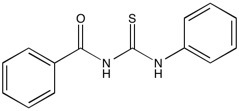TM-2-51 | HDAC8 activator
NMR (Conforms)

Available Options
| size : | Price | Quantity | |
|---|---|---|---|
| 10 mg | $50.00 | ||
| 50 mg | $190.00 |
TM-2-51 (4921-82-8) is a highly potent and isozyme selective activator of recombinant HDAC8. Increases the activity of HDAC8 by a factor of 12 at 10 μM. No activation of other HDACs is observed. TM-2-51 rescues the activity of catalytically compromised HDAC8 mutants in vitro.2
References/Citations:
1) Singh et al. (2011), Histone deacetylase activators: N-acetylthioureas as highly potent and isozyme selective activators for human histone deacetylase-8 on a fluorescent substrate; Bioorg. Med. Chem. Lett., 21 5920
2) Decross et al. (2014), Compromised Structure and Function of HDAC8 Mutants Identified in Cornelia de Lange Syndrome Spectrum Disorders; ACS Chem. Biol., 9 2157
3) Singh et al. (2015), Mechanism of N-acylthiourea Mediated Activation of Human Histone Deacetylase 8 (HDAC8) at Molecular and Cellular Levels; J. Biol. Chem., 290 6607
NMR (Conforms)
Safety Data Sheet:
Product Data Sheet:
Materials provided by Focus Biomolecules are for laboratory research use only and are not intended for human or veterinary applications. Please note that we do not sell to individuals and that all orders placed by non-research organizations will incur a $20 restocking/refund fee
TM-2-51 (4921-82-8) is a highly potent and isozyme selective activator of recombinant HDAC8. Increases the activity of HDAC8 by a factor of 12 at 10 μM. No activation of other HDACs is observed. TM-2-51 rescues the activity of catalytically compromised HDAC8 mutants in vitro.2
References/Citations:
1) Singh et al. (2011), Histone deacetylase activators: N-acetylthioureas as highly potent and isozyme selective activators for human histone deacetylase-8 on a fluorescent substrate; Bioorg. Med. Chem. Lett., 21 5920
2) Decross et al. (2014), Compromised Structure and Function of HDAC8 Mutants Identified in Cornelia de Lange Syndrome Spectrum Disorders; ACS Chem. Biol., 9 2157
3) Singh et al. (2015), Mechanism of N-acylthiourea Mediated Activation of Human Histone Deacetylase 8 (HDAC8) at Molecular and Cellular Levels; J. Biol. Chem., 290 6607
Calculate the molar concentration, mass or volume in a solution.
Concentration × Volume × Molecular Weight = Mass
Focus Biomolecules • Plymouth Meeting, PA USA • 1-855-FOCUS21
Focus Biomolecules
Plymouth Meeting, PA USA
1-855-FOCUS21
Website Created by Advanta Advertising LLC.

